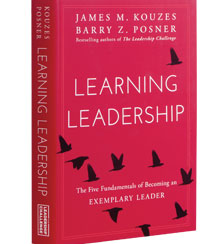Best Business Books 2016: Talent & Leadership
Thinking It Through
James M. Kouzes and Barry Z. Posner
Learning Leadership: The Five Fundamentals of Becoming an Exemplary Leader (Wiley, 2016)
*A TOP SHELF PICK
Amy Cuddy
Presence: Bringing Your Boldest Self to Your Biggest Challenges (Little, Brown, 2015)
Jeffrey Pfeffer,
Leadership BS: Fixing Workplaces and Careers One Truth at a Time (HarperBusiness, 2015)
Is leadership an art or a science? The consensus in recent years seems to have come down squarely on the side of science, as behaviorists and social researchers have examined every aspect of how people lead and are led. Armed with an ever-expanding battery of methods — from functional MRIs and saliva tests that measure hormonal responses to long-established personality tests to statistical patterning — experts have been inundating us with data about leadership practices, perceptions, effectiveness, and outcomes.
This rising quantity of quantification has surely improved our understanding of what superior leaders can achieve, and has given organizations valuable information to use when hiring and developing talent. But has it improved the quality of leadership in the real world? High turnover rates and a paucity of effective leaders suggest either that there’s no correlation between studying leadership and leading or that the scientific approach could benefit from a bit more art. After all, no one depicted leaders with greater penetration than Shakespeare, who never conducted a 360-degree assessment.
Interpreting data insightfully is surely as important as compiling and presenting it. So it’s no surprise that this year’s best business books on talent and leadership merge art with science to offer distinctive insights that are useful in everyday life and that resonate with human experience. Two of the books — new offerings by the famously skeptical Jeffrey Pfeffer and the influential team of James M. Kouzes and Barry Z. Posner — document and lament the shortage of outstanding leaders and propose wildly contrasting remedies. The third, a noteworthy debut by Amy Cuddy, takes a novel approach to helping individuals project the confidence that research shows is a chief characteristic of leadership. Each of these books is valuable and deserves recognition, but I choose Learning Leadership as the best business book of the year on this topic — for its humanity and grace, and its ability to find truth in a blend of art and science.
The Problem with Myths
With their five editions of The Leadership Challenge, Kouzes and Posner have set the standard for much of leadership writing over the last 30 years. The database that informs their work, based on millions of responses to detailed assessments delivered in thousands of organizations in every sector in both developed and developing countries, offers an unmatched resource in documenting what constitutes effective leadership.
Their new book, Learning Leadership: The Five Fundamentals of Becoming an Exemplary Leader, is written with passion and insight derived from decades of practice as well as research: Kouzes is ranked as one of the top executive educators and is an executive fellow at the Leavey School of Business at Santa Clara University, where Posner holds an endowed professorship. A glance at the book’s table of contents might suggest a fairly generic offering — a framework with five fundamentals, all of which sound more aspirational than concrete. But the authors’ wisdom and humanity set their book apart. So, too, does their conviction that good leadership is a skill that can be learned by anyone who seeks it, and that such learning contributes substantively to the sum of human happiness and fulfillment.
In addressing the perennial question of whether leaders are born or made, the authors tartly observe that they’ve never met a leader who wasn’t born, which is to say that everyone has the ability to become a better leader. Leadership is not a trait, nor is it reserved for those with charisma — those who, in the original meaning of the word, were kissed by the gods at birth. The “born leader” trope, in the authors’ view, is antithetical to the way real-life leaders operate. It functions as a fable or folk legend that discourages people at every level from working to become better leaders.
The authors unpack five myths that support these legends. My favorite is the talent myth, known in training and development circles as just finding the right person. Bluntly stating that “talent is overrated,” Kouzes and Posner cite research indicating that “getting better” bests “being good” when it comes to leading (and pretty much everything else). Their own experience interviewing thousands of people who have led others to make extraordinary things happen demonstrates that a desire to achieve excellence, the grit to persevere, and a willingness to engage people broadly in one’s effort are far more important than innate talent.
They also make quick work of the strengths myth, which holds that people increase their chances of success by playing to their strengths and outsourcing what they are weak at. This approach all too often results in people saying things like “I’m not a visionary, so I’m going to avoid sharing my perspective” or “I’m not a natural at giving praise, so why bother?” In fact, Kouzes and Posner’s research demonstrates that successful leaders make a habit of challenging themselves on their weaknesses.
Leadership, they argue, is within everyone’s reach, and the five fundamentals offer a template for how to get better by thoroughly analyzing a situation and critiquing your own performance in a constructive way. Self-awareness and a willingness to keep learning from every experience are the basic requirements, and the authors provide self-coaching exercises and reviews throughout that are useful, commonsensical, and free from jargon.
Anyone with a desire to improve his or her own leadership skills can benefit from reading this deeply encouraging book. My only quibble is with the sometimes redundant recaps and “action summaries” that conclude every chapter, which seem to have become de rigueur in business books. Leaving it to people to imagine how they might apply what they have learned instead of providing templates for every step might enrich how readers interpret a book’s insights.
The Pose of Power
Amy Cuddy is a Harvard Business School professor and social psychologist with an engagingly informal writing style, a compelling personal story, and a talent for ferreting out endless research studies in support of her thesis: that personal presence is a key to success in virtually any endeavor and that even the most nervous and insecure can learn how to comfortably project it.
There’s been an increased interest in leadership presence over the last few years, perhaps because simply being present has become one of the chief executive obstacles in our highly distracting 24/7 culture. The devices with which we constantly interact virtually require our minds to be in two (or more) places at once, making it impossible to fully inhabit the present moment. A frantic air of distraction hardly conveys leadership. Indeed, many positional leaders seem so preternaturally relaxed only because they are able to outsource their technological interactions. Reclaiming the capacity to communicate coherently and clearly, and to be fully available for what is happening in the moment, has thus become a way to hold ground and distinguish oneself as a leader.
What is presence? In Presence: Bringing Your Boldest Self to Your Biggest Challenges, Cuddy defines it as the state of being attuned to and able to comfortably express our true thoughts, feelings, values, and potential. It is, then, both an inside and an outside job. When we feel present, she notes, our speech, facial expressions, postures, and movements are aligned, synchronized, and focused: They add up. This harmony creates an internal–external convergence, otherwise known as poise, that others read as trustworthy and persuasive and that we ourselves experience as relaxed and calming.
But it’s tricky to achieve this state. Cuddy notes that self-affirmation, one of the most frequently advocated techniques for projecting confidence, is ineffective because it requires us to simply affirm what we may not actually believe (“I’m going to be great!” “I’m a winner!”). She cites numerous studies that confirm this. For example, social researchers have failed to find any decrease in cortisol, the stress hormone, in subjects who practice affirmations. The scientific literature bears out what common sense suggests: You can’t talk or think yourself into believing something you don’t actually believe.
You can, however, act yourself into feeling confident even if you are not. All you need is a clear and well-prepared message, control of your breath, and a knowledge of what physical postures are helpful and what postures can undermine you and betray your fear and feelings of powerlessness. Cuddy’s ingenious ways of showing people how to perform their way into presence are what made the TED talk that preceded her book a viral sensation. Having experienced a serious brain injury when in college, Cuddy came to this realization through painful personal learning. Her quest inspired her many experiments aimed at discerning precisely what helps people become more confident and forceful, and how they can feel powerful and able to influence events.
For example, she demonstrates the mechanisms that enable people who assume specific poses to become more relaxed, feel stronger, and manifest those positives to others. Mind follows body, she notes, because the body is continually sending information to the brain; this is also why breathing exercises, which she advocates, calm the autonomic nervous system. By practicing effective “power poses” — standing tall with arms akimbo, leaning in when standing at a table, raising your arms in a wide V while preparing for a speech, and in general being comfortable taking up space — even the nervous can calm the hormone storm within and inhabit a more persuasive way of being. Although deliberately practiced, the projected confidence is not fake because you don’t simply manifest it, you also feel it: Your body sends signals to your mind that you’re relaxed and in control.
This delightful book will be useful to anyone seeking to project a more powerful and relaxed presence as well as to leadership and development professionals looking for tools that can help their clients. It also offers a compendium of research on topics relating to presence, effective communication, and self-awareness. I do think the accumulation of citations, and Cuddy’s habit of backing up even tangential observations by referencing various studies, can start to wear on the reader. Perhaps this is understandable, given that this is Cuddy’s first book and she’s an academic. Still, it’s a promising, enlightening, and rewarding addition to the literature of leadership.
The Contrarian
Jeffrey Pfeffer’s previous bestseller, Power: Why Some People Have It — and Others Don’t (HarperBusiness), landed in 2010 like an icy blast amid the soft-hued descriptions that had recently become prevalent of how power is used and manifested in organizations. Thus did the Stanford Graduate School of Business professor introduce himself to the wider public as a fierce contrarian and realist in the Machiavellian mode. Leadership BS: Fixing Workplaces and Careers One Truth at a Time is sure to fortify this reputation.
Pfeffer’s target in the new book is “the leadership industry” — the authors, speakers, trainers, and consultants who have, in his view, offered myths and fables that aim to inspire people but that have little to do with how leadership is actually practiced. He also strongly objects to leaders who collaborate on books or leadership development programs (here’s looking at you, Jack Welch!) that whitewash their many faults and skim over the terrible compromises they’ve made in pursuit of success. Such an approach has set people up to feel disillusioned when leaders in their company fail to exhibit socially popular traits, or when they themselves are penalized or sidelined for trying to function as “servant leaders.”
Pfeffer takes particularly sharp aim at values-laden advocacy that urges would-be leaders to practice modesty, authenticity, truth telling, trust building, and putting others first. Although these might be highly moral traits, they are extremely rare among leaders, many of whom are narcissistic, put their own interests first, mask their true intentions, and practice situational ethics. It’s no coincidence that there are far more players than saints at the top of organization charts. Pfeffer offers specific examples of a few leaders who do engage in inclusive behaviors that benefit their organization in the long term, such as Alison Davis-Blake, former dean of the Ross School of Business at the University of Michigan, and Ken Thiry, CEO of DaVita, a kidney dialysis provider. But such cases are, in his view, exceptions in a world where those who are lionized for success can be dangerous to know.
Although Pfeffer’s pessimism is relentless, Leadership BS offers a useful and necessary corrective to leadership conversations that tend to become untethered to reality in their anticipation of a nirvana where people in power will all practice a kind of leadership Zen. And it is indeed noteworthy, as Pfeffer points out, that despite increasing resources devoted to leadership training and a strong market for leadership literature meant to motivate and inspire, people in real organizations report unprecedented levels of dissatisfaction and even misery, and are highly critical of the behavior of their bosses.
The spread of highly demanding, even invasive, technologies is no doubt partly to blame. But many organizational cultures have in effect become toxic, which is an indicator of purely human failure; Pfeffer is not shy about citing examples. In our collective zeal to inspire, we cause people to bring unrealistic expectations to their jobs and so set them up either to fail or to become corrosively cynical. He is especially scathing about the recent vogue for “authentic leadership,” worrying that by urging people to share their true responses rather than strategically assessing situations and adapting their behavior accordingly, we are telling them fairy stories about what is expected at leadership levels.
To Pfeffer, storytelling is essentially a con.
Pfeffer’s disdain for the role of storytelling as opposed to rigorous scientific investigation of how people actually lead suggests he has little tolerance for approaches that view leadership as an art or interpretive methods that seek to find a moral in the kind of narratives that people find helpful in their daily lives. To Pfeffer, storytelling is essentially a con. The reality that stories have been an artifact throughout human history and make up a formative cultural expression cuts little ice with this cold-eyed observer. Yet his unrelenting skepticism is expressed with wit, and his style is graceful and lively.
Pfeffer intends his work to be provocative, and he succeeds significantly. And as the other authors of this year’s crop of useful volumes point out, there is a big gap between much leadership advice — prescriptive, exhortatory, and aspirational — and how people actually experience their leaders. If we can’t muster up the presence of mind to recognize this state of affairs, we have little chance of learning better leadership.
Reprint No. 16413
Author profile:
- Sally Helgesen is an author, speaker, and leadership development consultant, whose most recent book is The Female Vision: Women’s Real Power at Work (with Julie Johnson; Berrett-Koehler, 2010).








